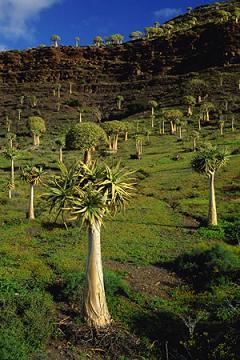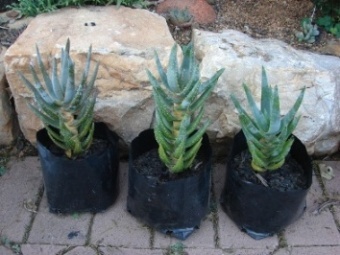Quiver Tree plants (selling singles now!)
Check my rate
| Main centres: | 1-3 business days |
| Regional areas: | 3-4 business days |
| Remote areas: | 3-5 business days |
Product information

Aloe Dichotoma (Kokerboom)
The quiver tree or Aloe dichotoma is probably the best known aloe found in
This distinctive tree aloe has smooth branches, which are covered with a thin layer of whitish powder that helps to reflect away the hot sun's rays. The bark on the trunk forms beautiful golden brown scales, but beware, the edges of these scales are razor sharp. The crown is often densely rounded as a result of the repeatedly forked branches, hence the species name dichotoma. (dichotomous meaning forked). The blue-green leaves are borne on terminal rosettes, but in juvenile plants the leaves are ranked in vertical rows. The bright yellow flowers are borne from June to July.
The young flower buds can be eaten and have a similar appearance and taste to asparagus. Sugar birds are drawn to these flowers in winter where they feed on the nectar produced by the flowers. Aloe dichotoma is an extremely tough tree that may reach an age of over 80 years and a height of approximately 7 metres.
This species is a conspicuous component of the arid parts generally known as
A common phenomenon in the branches of these trees is the huge communal nest of weavers that live and breed by the thousands. Here their young and unborn are safe from predators such as snakes and jackals.
The earliest record of A. dichotoma was made by Simon van der Stel (Governor of the Cape at the time) on his northward journey to the
Large trunks of dead trees are also hollowed out and used as a natural fridge. Water, meat and vegetables are stored inside it. The fibrous tissue of the trunk has a cooling effect as air passes through it, a so-called natural fridge.

Growing Aloe dichotoma
Aloe dichotoma features quite prominently in gardens all over
Plants such as Cotyledon orbiculata, Crassula rupestris, Cyphostemma juttae, and Tylecodon paniculata are special companion plants to quiver trees and will completely transform any garden. Alternatively, quiver trees can be grown in large containers. This is very rewarding as beautiful specimens can be positioned to enhance certain areas. Always use a good quality, loamy sandy soil with plenty of drainage chips at the bottom of containers. Bone meal is mixed into the soil to help feed the fleshy roots of plants.
 Left: The plants you are buying.
Left: The plants you are buying.
Sellining 1 Tree minimum
Plants will be sent to you with clean roots.
Are you looking for a specific aloe plant or would you like to only buy one? Ask a question on this page and I will ad any aloe you are looking for, satisfaction guaranteed! Many SA and Malagasi aloes available.....
Plants available include: Haworthia, Gasteria, Euphorbia, Crasula, Echeveria, Agave, Huernia.
Are you looking for a specific aloe plant or would you like to only buy one? Ask a question on this page and I will ad any aloe you are looking for, satisfaction guaranteed! Many SA and Malagasi aloes available.....
Plants available include: Haworthia, Gasteria, Euphorbia, Crasula, Echeveria, Agave, Huernia. |
